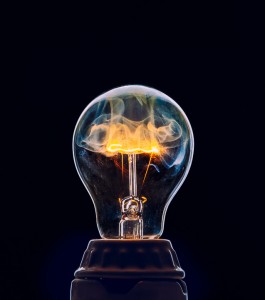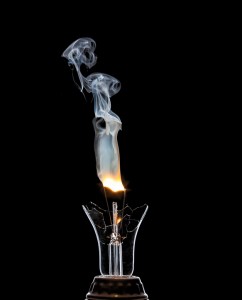The photo above shows what I call Light Bulb Smoke Photography. It is capturing the smoke rising from the burning filament of a light bulb. This sort of image is very easy to accomplish and in this tutorial I will explain how you can capture similar images.
How it Works
The glass globe of a light bulb has a vacuum inside it which prevents the filament in the light bulb from burning up. By breaking the glass of the light bulb and letting air get to the filament, the filament will burn and give off smoke when power is applied to the bulb. By slowly applying power to the light bulb you can get it to a point where it starts to glow and burn. The burning filament will smoke and creates interesting patterns. As the power is increased the filament will burn faster and will eventually burn up and break the electrical connection.
Capturing Smoke Inside the Globe

Another techinique is to leave the glass globe intact and break the vacuum by drilling a hole in the base of the light bulb. Because there is no vacuum in the bulb the filament will smoke and burn but smoke will be contained inside the glass globe. This gives another interesting photo opportunity.
Light Bulb Smoke Photography Tutorial – The Video
The following video tutorial shows the setup for photographing Light Bulb Smoke.
[vimeo url=”http://vimeo.com/71213783″ width=”640″ height=”480″ title=”0″ fs=”0″ portrait=”0″]Lighting Setup
To light this setup we want just the edges of the light bulb globe to appear lit while the background appears black. This is called Dark Field Illumination. I learned how to do this sort of lighting from this book Light Science and Magic: An Introduction to Photographic Lighting (this is an affiliate link).
In my implementation I placed a large softbox directly behind the light bulb and then taped a black piece of poster board onto the face of the softbox that was slightly smaller than the width of the softbox. The black poster board makes the background appear black. The light on the sides of the poster board highlight just the edge of the light bulb glass.
You will need to adjust the distance of light bulb from the softbox to that just the edges of the light bulb are highlighted. If the light bulb is too close to the softbox then the glass edges will appear black and the glass will not be visible in the image, if the light bulb is too far way then more than just the edges of the glass will be illuminated and you will not be able to see through the glass. So move it back and forth to find the sweet spot.
Electrical Fixture
The fixture is relatively simple. It is a wood box that contains a switch, a light dimmer, and a socket for the bulb. There is no need to build a specialized fixture, you could also use a household lamp plugged into a dimmer.
Wiring Diagram
Here is the wiring diagram for the fixture.

The Bulbs
Doing Light Bulb Smoke Photography requires a lot of light bulbs. I look for clear glass globes (not frosted), a simple single filament, and cheap. Here is a link to the ones I used in the above photos Feit Electric 60A/CL/MP-130 60-Watt A19 Household Bulb, Clear, 24 Pack
(this is an affiliate link so if you purchase I make a few pennies. It does not cost you anything additional).
Conclusion
Light Bulb Smoke Photography is relatively easy to do and you can get a lot of interesting shots as the smoke curls away from the filament. Give it a try and share with me any photos you might take. I’d love to see them.



[…] complete instructions can be found at his website, including the electrical map for his dimmer light (yes, you can probably build it – […]
[…] complete instructions can be found at his website, including the electrical map for his dimmer light (yes, you can probably build it – […]
This looks like an interesting project to do sometime in the near future. However, looking at the wiring diagram, the electrician in me says the black and white wire labels should be reversed. According to the N.E.C. color code, the black wire is used for the “hot” wire or voltage source and the white is the return or neutral conductor. If the plug is wired correctly with black to brass (or smaller blade) and white to silver (or larger blade) then opening the switch in your diagram would not remove power from the light socket and becomes an electrical shock hazard
[…] complete instructions can be found at his website, including the electrical map for his dimmer light (yes, you can probably build it – […]
Nice and concise tutorial. The video helps clarify the process very well.
I went out and bought a load of 100w bulbs and spent an evening snapping away.
I’ve put some up as a set on Flickr here: http://www.flickr.com/photos/mr_fr3nch/sets/72157642833347433/
Thanks.
You did a great job! I like the colors on the edge of the bulb, was that done with gels or in post-processing?
Fantastic idea! I am going to try this as a project for my advanced lighting class tomorrow! Only difference is that I will make the background blue with gels… We’ll see how it goes! Thank you for explaining everything in detail!
Hi! I have a few questions on how to do this sorta thing (I’m new when it comes to photography): firstly, is there a certain size bit I should use for the drill? Secondly, would my camera be suitable for this (I have a Canon Rebel XTi)? I would really love to try this, I just want to make sure it’s done properly! Thank you!
The size of the drill bit is not important. I use a 1/8″ drill bit, it is about the smallest that works without breaking the bit. I’ve used as large as a 1/4″.
A Canon Rebel XTi is a great camera for this. Almost any camera that can remotely trigger the flash should work.
Good luck and share your shots.
— Craig